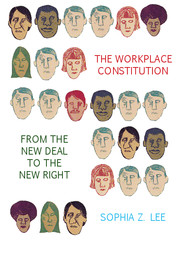
Sophia Lee’s new book makes contributions to the fields of constitutional law, labor law, employment discrimination, and administrative law.
Legal historians are always asked the question, “Who is your audience?” As someone who teaches, writes (often from an historical perspective), and once practiced in the fields of labor law, employment discrimination, constitutional law, and administrative law, I am as core a member of the audience for Sophia Z. Lee’s The Workplace Constitution: From the New Deal to the New Right as anyone could be. This book has challenged my assumptions and enriched my understanding in each of these fields.
The book’s overbroad title is somewhat misleading. Lee does not undertake to document the full range of efforts, legal and political, to constitutionalize the American workplace from the New Deal to the present. For example, despite its New Deal focus, the book does not explore debates as to the constitutional underpinnings of National Labor Relations Act’s core right to organize and engage in concerted activity.
It is, indeed, difficult to sum up in a short phrase what this book is really about. With the exception of Chapters 8 and 10, the book might well have been entitled “Constitutional Limits on Union Power: A Study in Neutral Principles.” Most of the book documents the assertion of constitutional rights against labor unions by two sometimes-overlapping groups: advocates for (mostly) black civil rights and “right-to-work advocates” (i.e., opponents of “compulsory” forms of unionization). Lee convincingly makes the novel argument that “liberals” and “conservatives” in the National Labor Relations Board (NLRB) and the courts took unexpected positions on the all-important state action doctrine in union-sector cases, and did so because it was impossible to forge a coherent legal position that treated unions as state actors when they engaged in race discrimination but as private actors when they used their statutory authority to compel dues-paying or other forms of participation. The result was that conservatives sometimes embraced the importation of constitutional norms into what would otherwise be purely statutory race discrimination claims, and liberals relied solely on statutory grounds in race discrimination cases which might, if constitutionalized, provide support for the conservatives’ position on “right to work” issues.
With Chapters 8 (on the Federal Communications Commission) and 10 (on the Federal Power Commission), however, the book becomes something much richer but also harder to capture. These chapters deal with debates in the two commissions about whether federal agencies are empowered, indeed compelled, by the Fourteenth Amendment to take affirmative steps to cure employment discrimination by private employers — not merely as a sideline as they go about their usual regulatory duties, but as an independent obligation. It makes perfect sense that Lee extended the book to include these chapters. Her focus on the NLRB and the Equal Enforcement Opportunity Commission (EEOC) led her there: it was the NLRB that first debated the existence of such a constitutional duty, and the EEOC helped to persuade the Federal Communications Commission to act on such a basis. That being said, these chapters give the book a more complex architecture.
 The Workplace Constitution makes two major, and linked, contributions to constitutional law scholarship. First, and most obviously, it offers a rich account of the development of the state action doctrine in the workplace arena. She documents the ways in which, time and again, the Supreme Court stopped short of making “hard” constitutional law in the key cases in this area, resting instead on sometimes-fanciful statutory interpretation aimed at avoiding constitutional questions. Second, through careful archival work, Lee documents the state-action debate outside the courts, both in social-movement and in administrative-agency discourse.
The Workplace Constitution makes two major, and linked, contributions to constitutional law scholarship. First, and most obviously, it offers a rich account of the development of the state action doctrine in the workplace arena. She documents the ways in which, time and again, the Supreme Court stopped short of making “hard” constitutional law in the key cases in this area, resting instead on sometimes-fanciful statutory interpretation aimed at avoiding constitutional questions. Second, through careful archival work, Lee documents the state-action debate outside the courts, both in social-movement and in administrative-agency discourse.
At first, I found myself skeptical as to whether the advocates and agency administrators who persisted in finding constitutional violations in the absence of Court-recognized state action were doing anything more than engaging in heightened rhetoric. But then I remembered: nowadays we no longer believe that the Constitution is simply what the Court says it is. Lee’s book thus stands as a fine case study of the vibrancy of constitutional discourse, in advocacy and governance, in the spaces created by the Court’s ambiguous and slow-moving state action decisions.
At times I wished Lee had developed a clearer set of analytical tools to distinguish among types of constitutional and quasi-constitutional discourse. For example, in discussing Brotherhood of Railroad Trainmen v. Howard, Lee says, in rapid succession: “the Court treated government-certified unions as state actors;” “the Court explicitly likened the actions of exclusive representatives to state action;” and the Court “alluded to the duty [of fair representation]’s constitutional roots.” These are all different; a clearer, more reliable vocabulary for distinguishing among them would have been helpful.
From the standpoint of labor law, it is nice to be reminded of a time when the unionized workplace mattered enough to be a significant locus for major developments in constitutional, employment-discrimination, and administrative law. It is particularly important for labor scholars today to engage sympathetically with the history of the right-to-work movement, given its centrality in contemporary politics. Liberals tend to be unwilling to understand that some of their preferred policies are genuinely experienced by conservative voters as depriving them of liberty, and that the choice of liberty over equality – often by voters who would benefit economically from redistribution – is not the result of ignorance or false consciousness. While Lee’s repeated references to “California activist housewives” left me wishing for a richer account of the motivations of grass-roots participants in the right-to-work movement, the book as it stands is a most welcome contribution to the literature on American conservatism.
In the area of employment discrimination law, the major contribution of the book is its exploration of the decentralized implementation of anti-discrimination norms within the federal government in the years immediately following the enactment of Title VII of the Civil Rights Act of 1964. The major missed opportunity of the book, given the centrality of constitutional rhetoric to her account, was its failure to explore the implications (rhetorical and legal) of Congress’ choice to use the Commerce Power rather than the Equal Protection Clause as the constitutional basis for the enactment of Title VII.
From an administrative law standpoint, Lee’s rich reading of the archival record gives a rare sense of the role of constitutional discourse in agency agenda-setting. Creative agency officials may well have been responding in the short term to the resource constraints faced by the EEOC during its early years: these commitments may not have lasted once the EEOC proved itself capable of filling its statutory role. Nonetheless, the decentralized agency enforcement of antidiscrimination norms is quite remarkable given these agencies’ gaps in expertise, their resource constraints, the likely pushback through congressional oversight, and the doctrinal uncertainties as to their authority to determine independently the constitutionality of their statutory mandates. One gets the sense that agency actors genuinely believed they were constitutionally required to prioritize the enforcement of antidiscrimination norms as an independent agenda, separate from their operational mission.
At the end of the day, though, I was left with the question, “how important was (and is) it that workplace anti-discrimination protections be constitutional rather than statutory?” It would have been helpful to have a better sense of how, and how much, Lee thinks it really matters. Reliance on statutory interpretation always leaves open the possibility that Congress will pass new legislation to mandate a contrary result, but the threat of Congressional action does not play much of a part in Lee’s account. Absent that threat, why is it so important that the Constitution be pressed into service? Reading this book, one could say that a set of anti-discrimination norms grew out of World War II, the Cold War, and the civil rights movement, and that these norms independently infused the courts’ interpretation of the Equal Protection Clause, Congress’ statutory agenda, and the self-image of agency administrators. The statutory expression of these norms need not be viewed as second-best to their constitutional expression. Indeed, in the area of gender, Congress was way ahead of the Court’s interpretation of the Equal Protection Clause insofar as it accorded race and gender discrimination essentially equal treatment under Title VII. (The presence of a bona fide occupational qualification for gender and its absence for race is the one exception.) Lee speculates that Justices Marshall and Brennan repudiated the disparate impact cause of action as a constitutional doctrine because they wanted to restrict incursions into the power of the post-New-Deal state. But their position may be a more genuine expression than Lee allows of the principle that anti-discrimination law functions best when statutes (and expert agencies) rather than constitutional doctrines (and non-expert agencies) take the lead.
This essay is part of a six-part series, The Struggle Over the Constitution in the Workplace.




